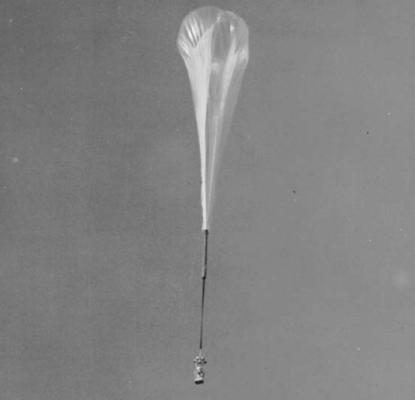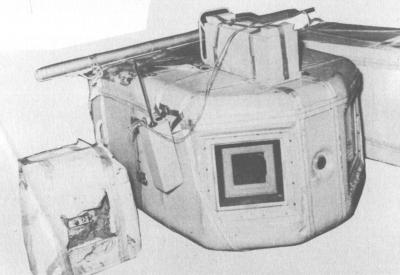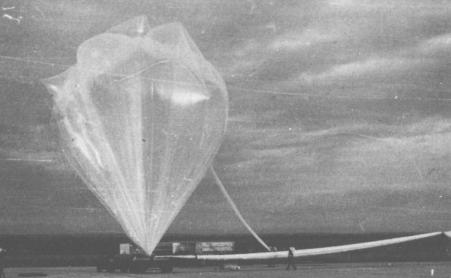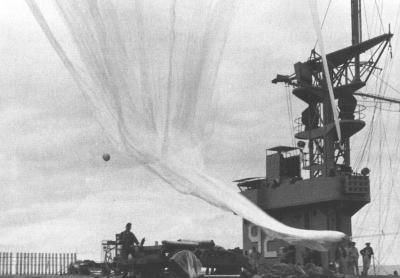Reconnaissance Balloons (WS-119L / WS-461L)
Project Skyhook
In 1947, the U.S. Navy began Project Skyhook, which used very large unmanned plastic (polyethylene) balloons to loft research payloads of various kinds (e.g. cosmic ray research) to altitudes of up to 30 km (100000 ft). The initial prime contractor for the Navy's Skyhook balloons was the Aeronautical Division of General Mills, Inc. Skyhook eventually became a very successful program, and its balloon technology was also used by the Air Force. In fact, the name Skyhook became a synonym for large high-altitude plastic balloons, even if they were launched by other agencies under different programs.
 |
| Photo: Office of Naval Research |
| Skyhook balloon |
At low level immediately after launch, the lifting gas (hydrogen or helium) in Skyhook balloons formed a small bubble at the top of the envelope, giving the whole balloon a rather "limp" look. At the lower air pressure at higher altitudes, the gas expanded and eventually filled the whole envelope, which could reach diameters of more than 30 m (100 ft) in some balloon models. High-flying Skyhook balloons provided an excellent stimulus for UFO/"Flying Saucer" sightings, and several balloons, which were lost by the military's visual and radar tracking systems, were "tracked" by following local UFO reports across the continent.
Project Gopher
When the Cold War began soon after the Second World War, U.S. military planners had the problem that they had virtually no information about what was going on in vast areas of the Soviet territory. Photo reconnaissance aircraft were used to obtain coverage of areas near the borders, and there were even very few overflights of the Soviet interior in the early 1950s. But these missions were extremely risky, and couldn't provide enough information for a good assessment of Soviet military strength. Satellites were still too far in the future, and therefore reconnaissance balloons were proposed as a solution for the problem.
In July 1950, Charles B. Moore of General Mills had conducted four test flights of Skyhook-type balloons with a camera payload. To the U.S. Air Force he presented the concept of camera-equipped balloons, which could float across the Soviet Union using strong winds (the "jet stream") at very high altitude, above the reach of Soviet air defences. In November 1950, the USAF officially began the development of a balloon reconnaissance system under secret project MX-1594 Gopher.
Design goal for Project Gopher was a balloon, which could carry a 225 kg (500 lb) payload gondola to 21000 m (70000 ft), and remain there at constant altitude for at least 16 days. Originally it had been hoped that Gopher could conduct the first operational missions by the end of 1951, but this proved to be far too optimistic. A series of test flights in 1952 was only partially successful, mainly because of continuing problems during balloon launch and with payload reliability. Because the USAF was dissatisfied with General Mills' progress, the balloon production contract was terminated in August 1952, and further balloons were ordered from Winzen Research. Project Gopher was a top secret project, but the balloon test flights could obviously not be hidden from the public. Therefore all test flights were officially part of Project Moby Dick (MX-1498), the USAF's unclassified research balloon project. Moby Dick had been started around the same time as Gopher, and used Skyhook balloons to measure global high-altitude wind patterns. Gopher's camera gondolas, which could parachute to earth anywhere after a test flight, were accordingly labeled as Air Force property (together with a fire hazard warning to discourage potential souvenir hunters).
 |
| Drawing: USAF |
| Typical Gopher balloon layout |
Skyhook balloons could be filled with either hydrogen or helium, depending on the desired flight altitude and duration, but for operational Gopher missions, hydrogen would be used. The balloons held a constant altitude using barometric switches, which would release ballast whenever the balloon dropped below a certain mimimum altitude. Maximum altitude was limited by the fact that the envelopes were open at the lowest point. At peak altitude, the lifting gas expanded so far that it started venting out at the bottom of the balloon, preventing further rising. This feature also prevented bursting due to internal over-pressure (unless the balloon rose too fast, as e.g. after payload release). Generally, the balloons reached maximum altitude during day time, when the sun heated the lifting gas, and descended during the night when the gas cooled again. Two types of balloon envelope were produced for Gopher, the 128TT and the 66CT. At high altitude, the 128TT inflated to a height of about 54 m (176 ft) and a diameter of about 39 m (128 ft). The 66CT was a cylindrical shape of about 20 m (66 ft) maximum diameter. The larger 128TT could reach higher altitudes than the 66CT, but early production 128TTs were too unreliable. They ruptured very easily during launch, which led to an unacceptably high failure rate. Even though later 128TTs were somewhat improved, about half the balloons prepared for Project Gopher were 66CTs to ensure an acceptable launch success rate.
Gopher's AN/DMQ-1 payload consisted of a gondola with the reconnaissance camera system. The main camera had two angled lenses at the bottom of the gondola, and took pictures at fixed intervals (6.25 minutes in the 66CT, 12.5 minutes in the 128TT). A second camera took wide-angle panoramic photos to determine the general geographical location of the balloon. A small photoelectric cell at the bottom of the gondola automatically shut down the cameras when it became too dark for useful photos. To recover the gondola, it was cut loose either automatically after a predefined time, or by radio command when a suitable recovery area had been reached. The gondola package then descended under a parachute. In balloon and camera test flights, the gondola would land on the ground, but in operational reconnaissance missions, it would be caught and hauled in in mid-air by specially converted C-119F cargo aircraft. There was also an ELINT (Electronic Intelligence) payload package, designated AN/DMQ-2, but its development was not completed in time, and it would therefore never be used operationally.
 |
| Photo: R.W. Koch |
| AN/DMQ-1 gondola |
WS-119L
In July 1953, the USAF finally decided to develop Gopher into the WS-119L operational balloon reconnaissance system, codenamed Grandson. In spring 1955, WS-119L was finally ready for operational training, and the program's code name was changed again, to Grayback. Between May and October that year, more than a hundred WS-119L balloons were launched under operation "Moby Dick Hi" (as usual, the Moby Dick name was used as cover). Although only 11 successful mid-air recoveries were made in 33 attempts, WS-119L was considered ready for use at the end of 1955. President Eisenhower gave approval to begin the overflights in January 1956, but had the flight altitude of the balloons limited to 16800 m (55000 ft). This was reportedly done, because the higher-flying Lockheed U-2 aircraft was under development at that time, and the Soviets should get no unnecessary motivation to develop new very high-altitude interceptor aircraft and missiles before the U-2 had begun its overflight program.
The USAF had set up WS-119L launch sites at five locations in Scotland, Norway, Germany (2) and Turkey. An official statement was issued, saying that scientific Moby Dick balloons would be launched on extended flights in the northern hemisphere. To support this cover story, a total of 30 research balloons were launched from January to July 1956 from Hawaii, Okinawa and Alaska under operation White Cloud. The code name for the WS-119L reconnaissance flights was Genetrix. Operational WS-119L payloads had a tracking beacon, which was activated at a preset time several days after launch. This time was calculated to occur after the balloon had exited Soviet or Chinese air space, but before it sank too low because of loss of gas and ballast depletion (the gondola was automatically cut free if the balloon descended below 30000 ft). The tracking beacons were needed by the recovery teams to locate the balloons.
 |
| Photo: Robert Burch |
| Launch of WS-119L balloon |
Between 10 January and 6 February, a total of 448 balloons were launched, and resulted in 44 successful camera gondola recoveries. Of the about 380 balloons, which actually reached Soviet airspace, more than 300 were either shot down or came down prematurely because of malfunctions or ballast depletion. The balance of the unsuccessful balloons reached the recovery zones, but couldn't be retrieved for various reasons. The end of the Genetrix flights was caused by the relatively low rate of success as well as the increasing political problems caused by the overflights. The Soviets eventually displayed captured gondolas to the public, explaining that they contained reconnaissance cameras and no meteorological equipment.
The Genetrix photos covered only a small part (8%) of the Soviet and Chinese land mass. Because of the balloons' drift pattern, particularly interesting areas in high latitudes were not covered at all. Nevertheless, Genetrix was not considered a complete failure. The high-altitude camera system made photos of excellent quality, and the WS-119L mid-air-retrieval principle would be used several years later for the retrieval of film capsules from the United States' first photo-reconnaissance satellites.
Designation notes:
- The 119L label was reused for the C/KC-135 transport/tanker system only a few years after the end of Genetrix. While it is not unusual that numbers of terminated Weapon Systems were reused, the reassignment of 119L was particularly quick. It's possible that this was done as a security measure (any requests for files about System 119L could be diverted to the C-135 program). The balloon reconnaissance program itself remained classified until the mid-1980s.
- The AN/DMQ designations of the WS-119L payload packages may have been a kind of cover designation. The "M" in "DMQ" designates meteorological equipment, which the packages were officially but not in reality.
WS-461L
In January 1957, the USAF's ARDC (Air Research and Development Command) began a new balloon reconnaissance program, designated WS-461L. The new system would use an improved balloon, which could float for almost a month at 30 km (100000 ft), beyond the reach of Soviet air defenses. To make high-resolution photographs from this altitude, Itek Corp. developed the new HYAC-1 panaramic camera system with a 12-inch (30.5 cm) focal length F/5 lens. Using a pivoting lens, the HYAC-1 could create hi-res photos with a 120° field-of-view.
While WS-119L balloons used the winter jetstream to cross the Soviet Union from west to east, WS-461L used the higher summer jetstream, which flows in the opposite direction. At WS-461L's operating altitude, the thermal properties of the balloon envelope, its volume, and the amount of hydrogen gas can be balanced in such a way that the balloon never descends below a critical altitude with minimal use of ballast. This effectively allows round-the-world trips of the balloons. As on the WS-119L balloons used for the Genetrix overflights, the payload gondola of a WS-461L balloon was to be cut down by a radio command. Because this system had sometimes failed on WS-119L, the newer balloons had an optional backup, which would cut down the gondola after a fixed amount of time.
 |
| Photo: Leroy C. Stables |
| Launch of WS-461L balloon |
WS-461L was ready for operational use in spring 1958, but after the less than encouraging results of WS-119L, President Eisenhower was very reluctant to approve overflights of the USSR. But the high quality of the HYAC-1's photos and the pressing need for intelligence on the Soviet ICBM program eventually led to a go-ahead decision in late June 1958. The overflight operation, named "Melting Pot", launched its balloons from the deck of the U.S. Navy ship USS Windham Bay (TCVU-92), a World War II escort carrier converted to an aircraft ferry. As usual, the operation was announced as a series of scientific balloon launches. To back up this cover story, seven WS-461L balloons (serialled S-423 through S-429) without camera systems were launched from various locations in the Pacific Ocean between 3 and 11 July. On the next three days, the three operational WS-461L balloons, S-430 to S-432, were launched, followed by three more "cover launches" afterwards. The reconnaissance balloons worked as designed, and apparently crossed the Soviet Union unharmed. However, the cut-down timer had been set - erroneously, and against the President's orders - to 400 hours. This would have been easily enough to reach NATO airspace during the prime time of the summer jetstream in June, but not in July, when the stream was already getting weaker. This fact was known to the Air Force, but nobody thought to either deactivate the timer or extend its lifetime after the delayed approval for the whole operation. In the end, the balloons almost made it, but the timers ran out when the balloons were still over Poland.
Eisenhower was furious over this operational, intelligence (state-of-the-art camera systems fell into Soviet hands) and diplomatic fiasco, and this meant the immediate end for the USAF's balloon reconnaissance program. Program WS-461L was formally terminated in 1961, but remained highly classified for many years later. In hindsight, the most useful results of the program was the development of the HYAC-1 high-resolution high-altitude camera system, which formed the technology base of the camera systems in the first U.S. photo reconnaissance satellites.
Specifications
Note: Data given by several sources show slight variations. Figures given below may therefore be inaccurate!
Data for WS-119L (128TT, 66CT) and WS-461L balloons:
| WS-119L (128TT) | WS-119L (66CT) | WS-461L | |
|---|---|---|---|
| Diameter (fully inflated) | 39 m (128 ft) | 20 m (66 ft) | ? |
| Max. Altitude | 26 km (85000 ft) | 18 km (60000 ft) | 30 km (100000 ft) |
| Max. Flight Time | 8 days | 7 days | ~ 30 days |
Main Sources
[1] Curtis Peebles: "The Moby Dick Project", Smithsonian Institution Press, 1991
[2] Charles Stephenson: "The Genetrix Balloons",
Osprey Publishing, 2004
[3] B.D. Gildenberg, "The Cold War's Classified Skyhook Program",
article in Skeptical Inquirer, May/June 2004
Back to Directory of U.S. Military Rockets and Missiles, Appendix 4
Last Updated: 21 March 2006